1995 GMC SIERRA weight
[x] Cancel search: weightPage 215 of 488
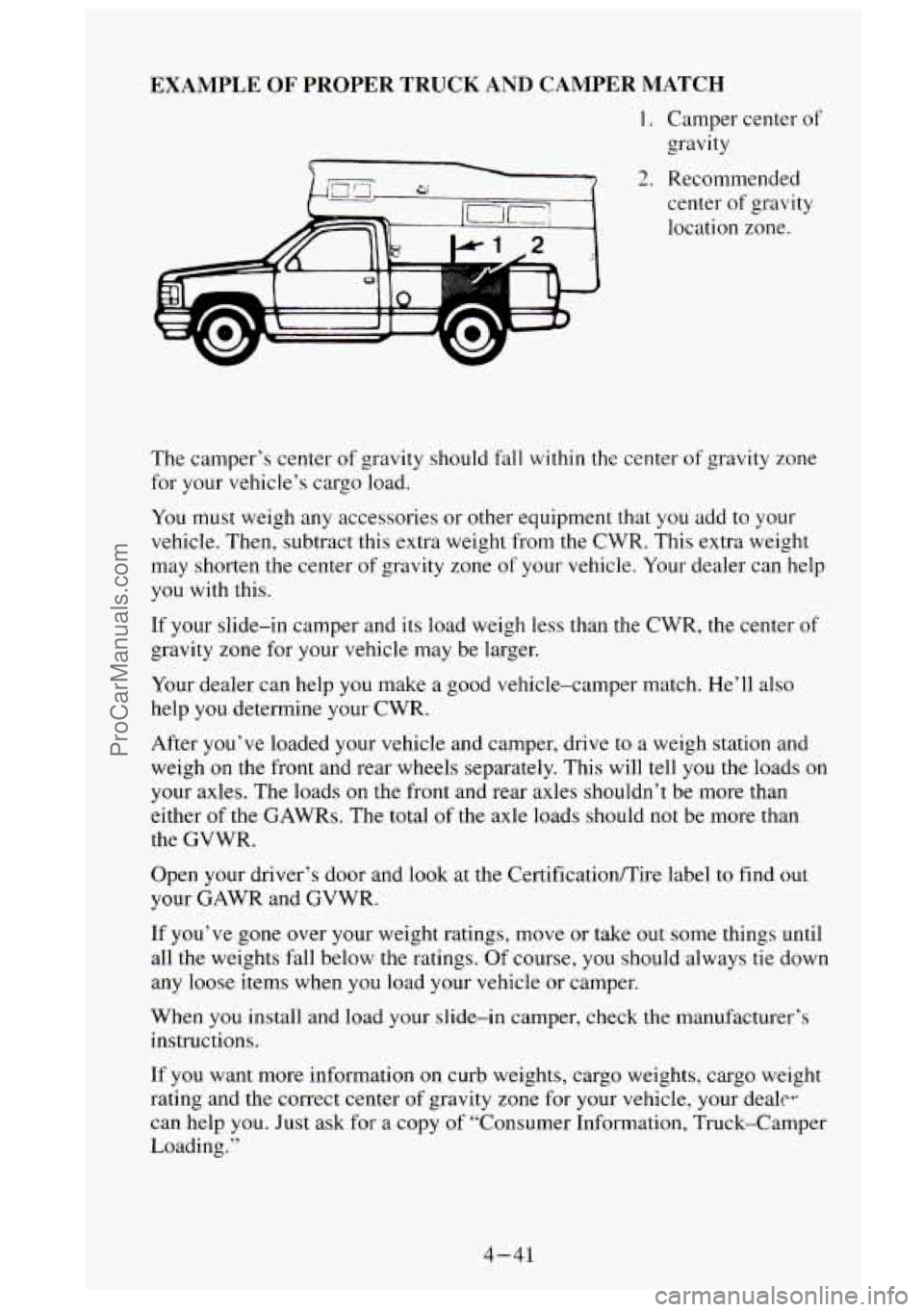
EXAMPLE OF PROPER TRUCK AND CAMPER MATCH
I. Camper center of
gravity
2. Recommended
center
of gravity
location zone.
The camper’s center of gravity should fall within the center
of gravity zone
for your vehicle’s cargo load.
You must weigh any accessories or other equipment that you add to your
vehicle. Then, subtract this extra weight from the
CWR. This extra weight
may shorten the center
of gravity zone of your vehicle. Your dealer can help
you with this.
If your slide-in camper and its load weigh less than the CWR, the center
of
gravity zone for your vehicle may be larger.
Your dealer can help you make a good vehicle-camper match. He’ll also
help you determine your CWR.
After you’ve loaded your vehicle and camper, drive
to a weigh station and
weigh
on the front and rear wheels separately. This will tell you the loads on
your axles. The loads on the front and rear axles shouldn’t be more than
either of the GAWRs. The total
of the axle loads should not be more than
the
GVWR.
Open your driver’s door and look at the CertificatiodTire label to find out
your
GAWR and GVWR.
If you’ve gone over your weight ratings, move or take out some things until
all the weights fall below the ratings.
Of course, you should always tie down
any loose items when you load your vehicle
or camper.
When you install and load your slide-in &‘@er, check the manufacturer’s
instructions.
If you want more information on curb weights, cargo weights, cargo weight
rating
and the correct center of gravity zone for your vehicle, your dealer
can help you. Just ask for a copy of “Consumer Information, Truck-Camper
Loading.”
4-41
ProCarManuals.com
Page 216 of 488
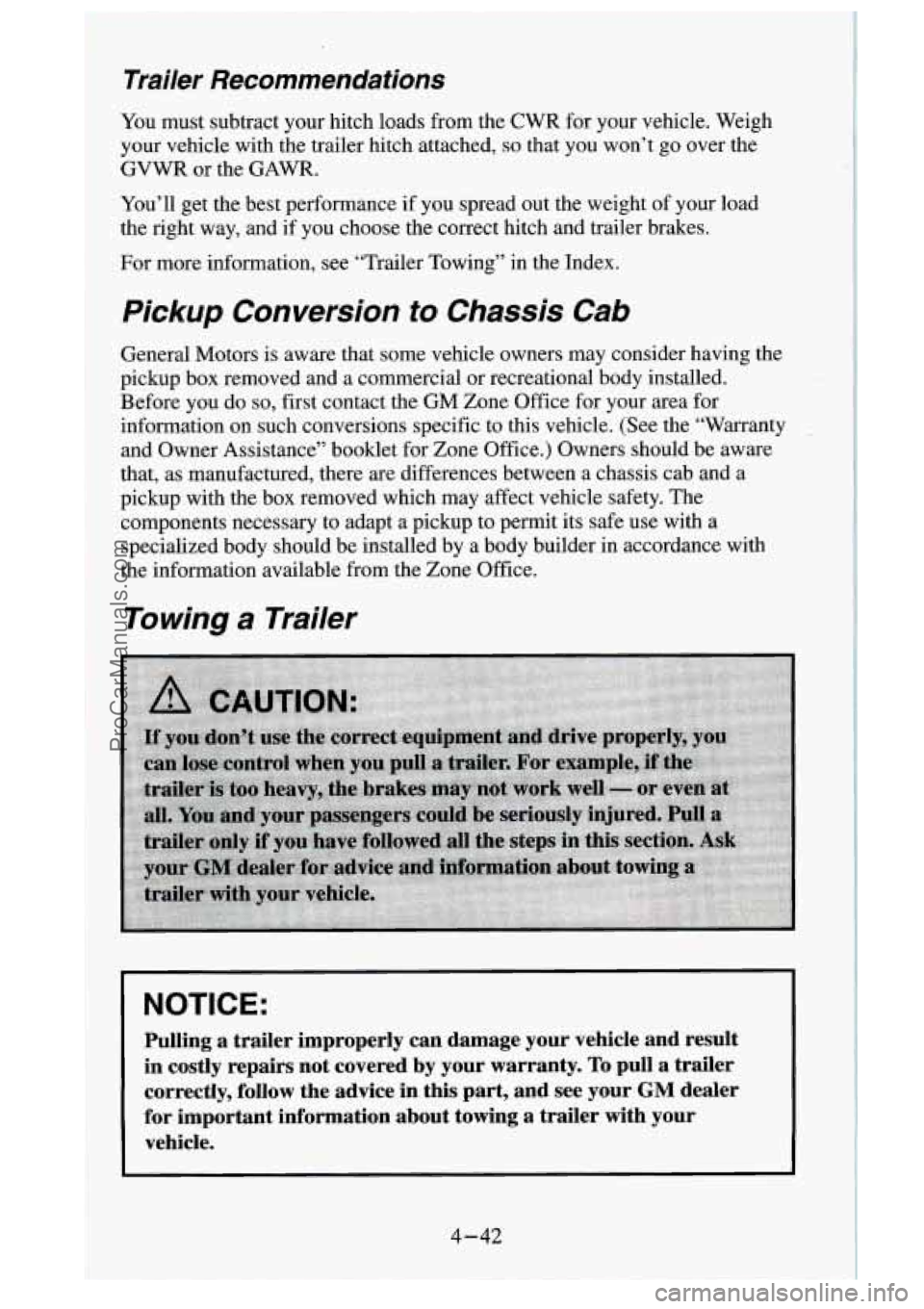
Trailer Recommendations
You must subtract your hitch loads from the CWR for your vehicle. Weigh
your vehicle with the trailer hitch attached,
so that you won’t go over the
GVWR or the
GAM.
You’ll get the best performance if you spread out the weight of your load
the right way, and if you choose the correct hitch and trailer brakes.
For more information, see “Trailer Towing” in the Index.
Pickup Conversion to Chassis Cab
General Motors is aware that some vehicle owners may consider having the
pickup box removed and a commercial or recreational body installed.
Before you do
so, first contact the GM Zone Office for your area for
information on such conversions specific to this vehicle. (See \
the “Warranty
and Owner Assistance” booklet for Zone Office.) Owners should be aware
that, as manufactured, there are differences between a chassis cab and a
pickup with the box removed which may affect vehicle safety. The
components necessary to adapt a pickup to permit its safe use with a
specialized body should be installed by a body builder in accordance with
the information available from the Zone Office.
Towing a Trailer
Pulling a trailer improperly can damage your vehicle and result\
in costly repairs not covered by your warranty. To pull a trailer
correctly, follow the advice
in this part, and see your GM dealer
for important information about towing a trailer with your vehicle.
4-42
ProCarManuals.com
Page 217 of 488
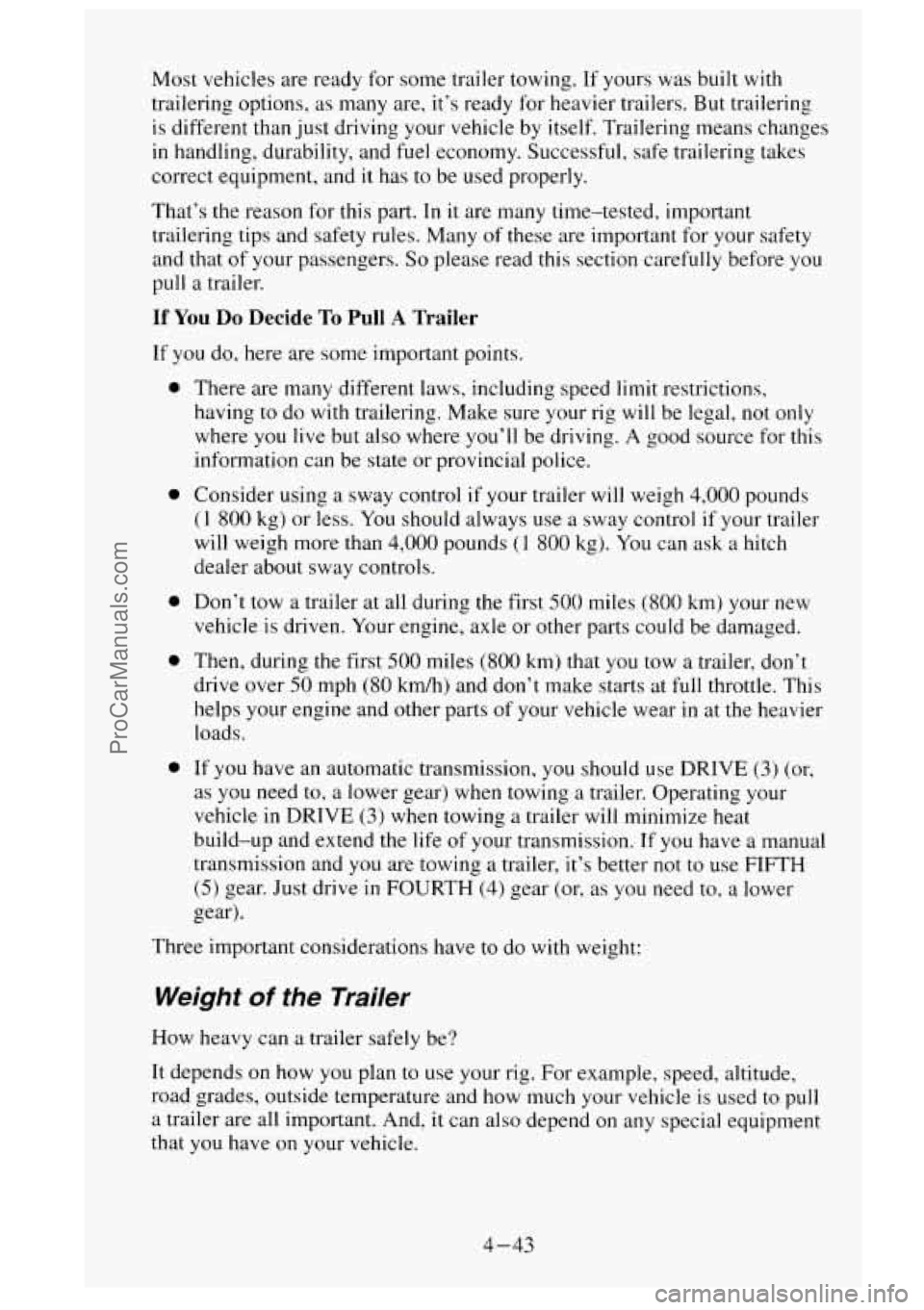
Most vehicles are ready for some trailer towing. If yours was built with
trailering options,
as many are, it’s ready for heavier trailers. But trailering
is different than just driving your vehicle by itself. Trailering means changes
in handling, durability, and fuel economy. Successful, safe trailering takes
correct equipment, and
it has to be used properly.
That’s the reason for this part.
In it are many time-tested, important
trailering tips and safety rules. Many of these are important for your safety
and that of your passengers.
So please read this section carefully before you
pull a trailer.
If You Do Decide To Pull A Trailer
If you do, here are some important points.
e
e
a
0
a
There are many different laws, including speed limit restrictions,
having to do with trailering. Make sure your rig will be legal, not only
where you live but also where you’ll be driving.
A good source for this
information can be state or provincial police.
Consider using
a sway control if your trailer will weigh 4,000 pounds
(I 800 kg) or less. You should always use a sway control if your trailer
will weigh more than
4,000 pounds (1 800 kg). You can ask a hitch
dealer about sway controls.
Don’t tow
a trailer at all during the first 500 miles (800 km) your new
vehicle
is driven. Your engine, axle or other parts could be damaged.
Then, during the first
500 miles (800 km) that you tow a trailer, don‘t
drive over
50 mph (80 kdh) and don’t make starts at full throttle. This
helps your engine and other parts of your vehicle wear
in at the heavier
loads.
If you have an automatic transmission, you should use DRIVE (3) (or,
as you need to, a lower gear) when towing a trailer. Operating your
vehicle in DRIVE
(3) when towing a trailer will minimize heat
build-up and extend the life
of your transmission. If you have a manual
transmission and you are towing
a trailer, it’s better not to use FIFTH
(5) gear. Just drive in FOURTH (4) gear (or, as you need to, a lower
gear).
Three important considerations have
to do with weight:
Weight of the Trailer
How heavy can a trailer safely be?
It depends on how you plan to use your rig. For example, speed, altitude,
road grades, outside temperature and how much your vehicle is used
to pull
a trailer are all important. And, it can
also depend on any special equipment
that you have on your vehicle.
4-43
ProCarManuals.com
Page 218 of 488
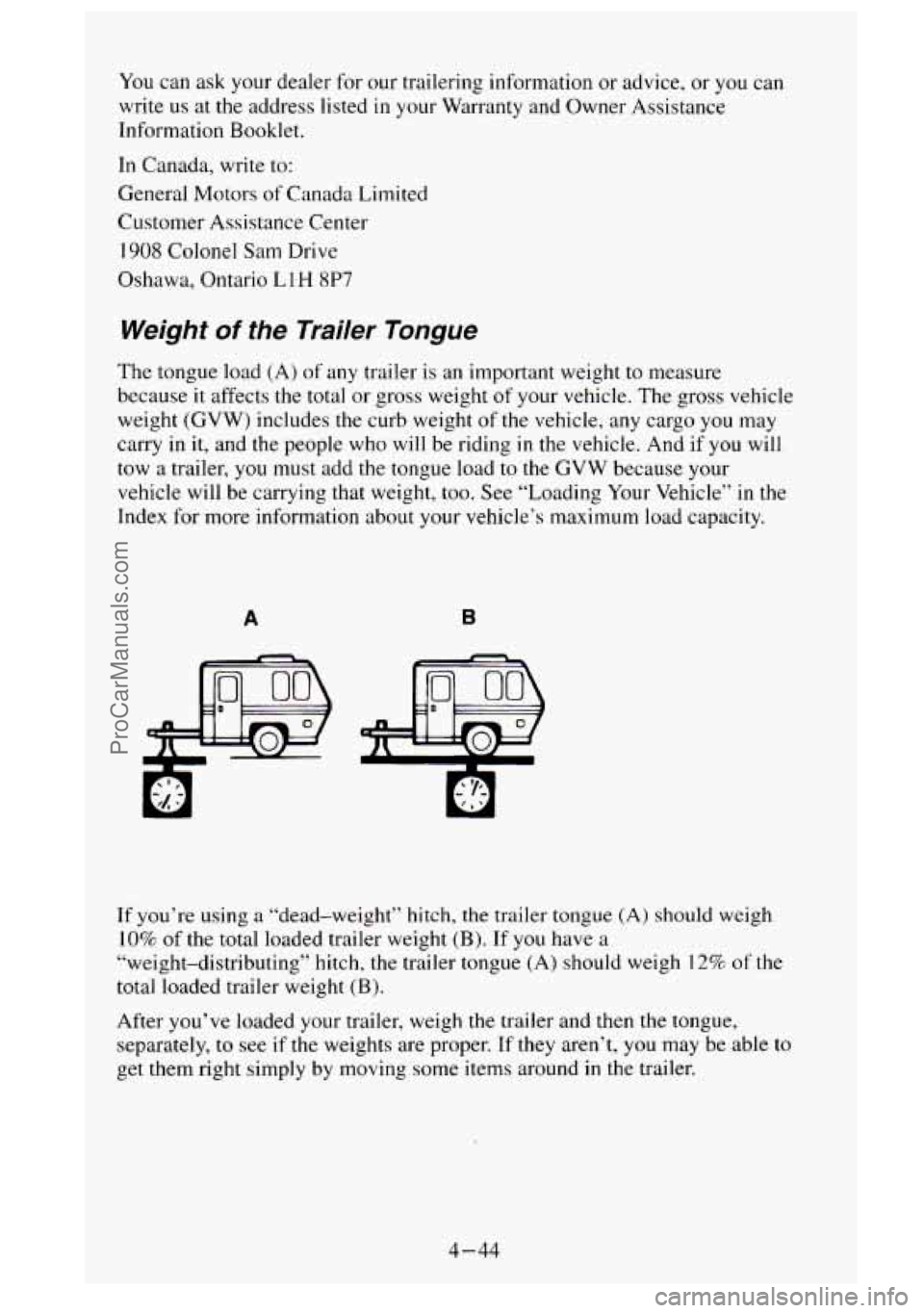
You can ask your dealer for our trailering information or advice, or you can
write us at the address listed
in your Warranty and Owner Assistance
Information Booklet.
In Canada, write to:
General Motors
of Canada Limited
Customer Assistance Center
1908 Colonel Sam Drive
Oshawa, Ontario
Ll H 8P7
Weight of the Trailer Tongue
The tongue load (A) of any trailer is an important weight to measure
because
it affects the total or gross weight of your vehicle. The gross vehicle
weight (GVW) includes
the curb weight of the vehicle, any cargo you may
carry
in it, and the people who will be riding in the vehicle. And if you will
tow a trailer, you must add the tongue load to
the GVW because your
vehicle will be carrying that weight, too. See “Loading Your Vehicle”
in the
Index
for more information about your vehicle’s maximum load capacity.
A B
If you’re using a “dead-weight” hitch, the trailer tongue (A) should weigh
10% of the total loaded trailer weight (B). If you have a
“weight-distributing” hitch,
the trailer tongue (A) should weigh 12% of the
total loaded trailer weight
(B).
After you’ve loaded your trailer, weigh the trailer and then the tongue,
separately,
to see if the weights are proper. If they aren’t, you may be able to
get them right simply by moving some items around in the trailer.
4-44
ProCarManuals.com
Page 219 of 488
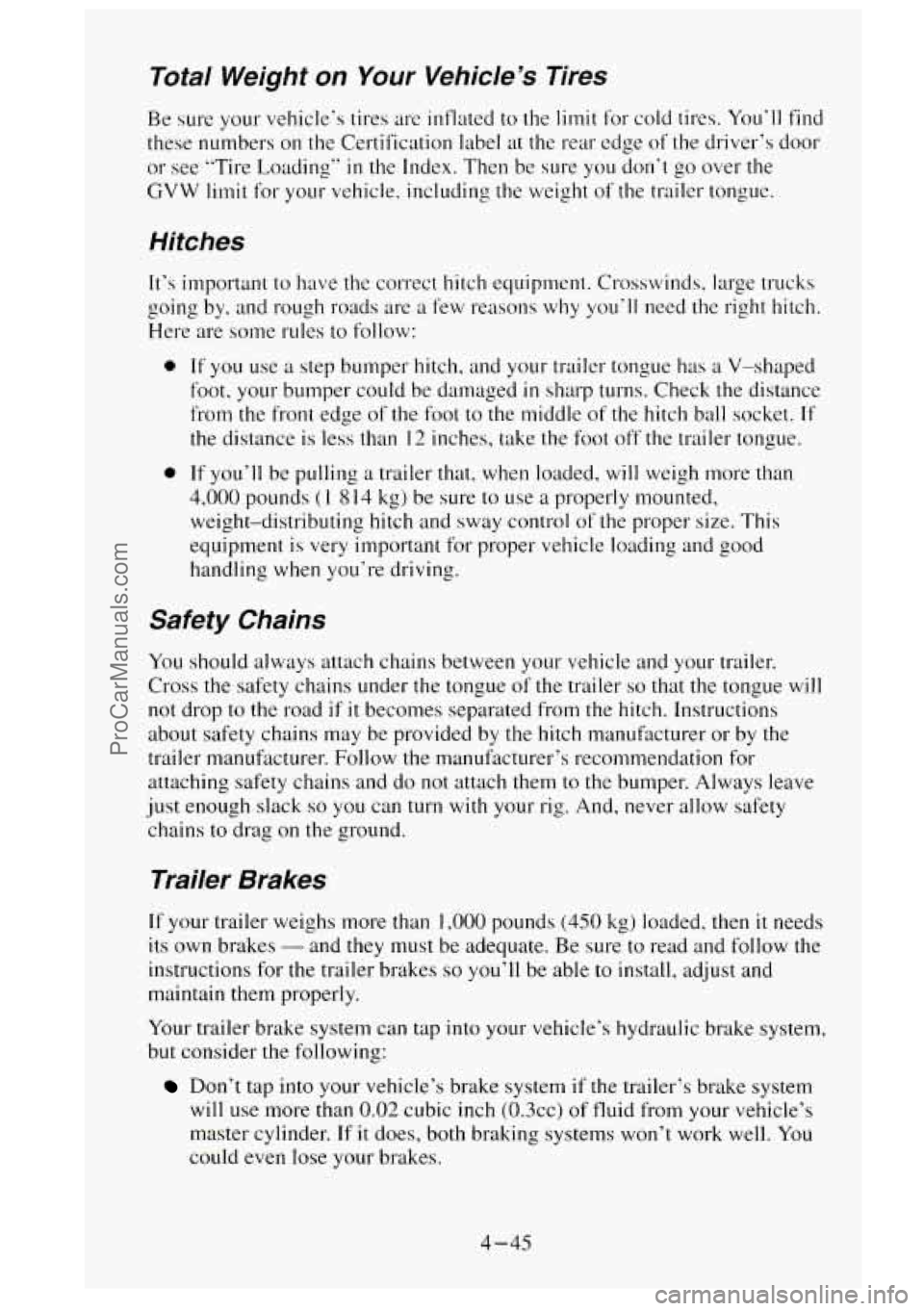
Total Weight on Your Vehicle’s Tires
Be sure your vehicle‘s tires are inflated to the limit for cold tires. You’ll find
these numbers on the Certification label at the rear
edge of the driver’s door
or see “Tire Loading“
in the Index. Then be sure you don‘t go over the
GVW limit for your vehicle, includins the weight of the trailer tongue.
Hitches
It’s important to have the correct hitch equipment. Crosswinds, large trucks
going by, and rough roads are
a few reasons why you’ll need the right hitch.
Here are some rules to follow:
e
e
If you use a step bumper hitch, and your trailer tongue has a V-shaped
foot. your bumper could be damaged
in sharp turns. Check the distance
from the front edge
of the foot to the middle of the hitch ball socket. If
the distance is less than 12 inches, take the foot off the trailer tongue.
If you‘ll be pulling a trailer that, when loaded,
will weigh more than
4,000 pounds
( 1 8 14 kg) be sure to use a properly mounted,
weight-distributing hitch and sway control
of the proper size. This
equipment is very important for proper vehicle loading and good
handling when you’re driving.
Safety Chains
You should always attach chains between your vehicle and your trailer.
Cross the safety chains under the tongue
of the trailer so that the tongue will
not drop to the road if it becomes separated from the hitch. Instructions
about safety chains may be provided by the hitch manufacturer or by the
trailer manufacturer. Follow the manufacturer’s recommendation for
attaching safety chains and do not attach them to the bumper. Always leave
just enough slack
so you can turn with your rig. And, never allow safety
chains to drag on the ground.
Trailer Brakes
If your trailer weighs more than 1,000 pounds (450 kg) loaded, then it needs
its own brakes
- and they must be adequate. Be sure to read and follow the
instructions for the trailer brakes
so you’ll be able to install. adjust and
maintain them properly.
Your trailer brake system can tap into your vehicle’s hydraulic brake system,
but consider the following:
Don’t tap into your vehicle’s brake system if the trailer’s brake system
will use more than 0.02 cubic inch (0.3~~)
of fluid from your vehicle’s
master cylinder.
Tf it does, both braking systems won’t work well. You
could even lose your brakes.
4-45
ProCarManuals.com
Page 220 of 488
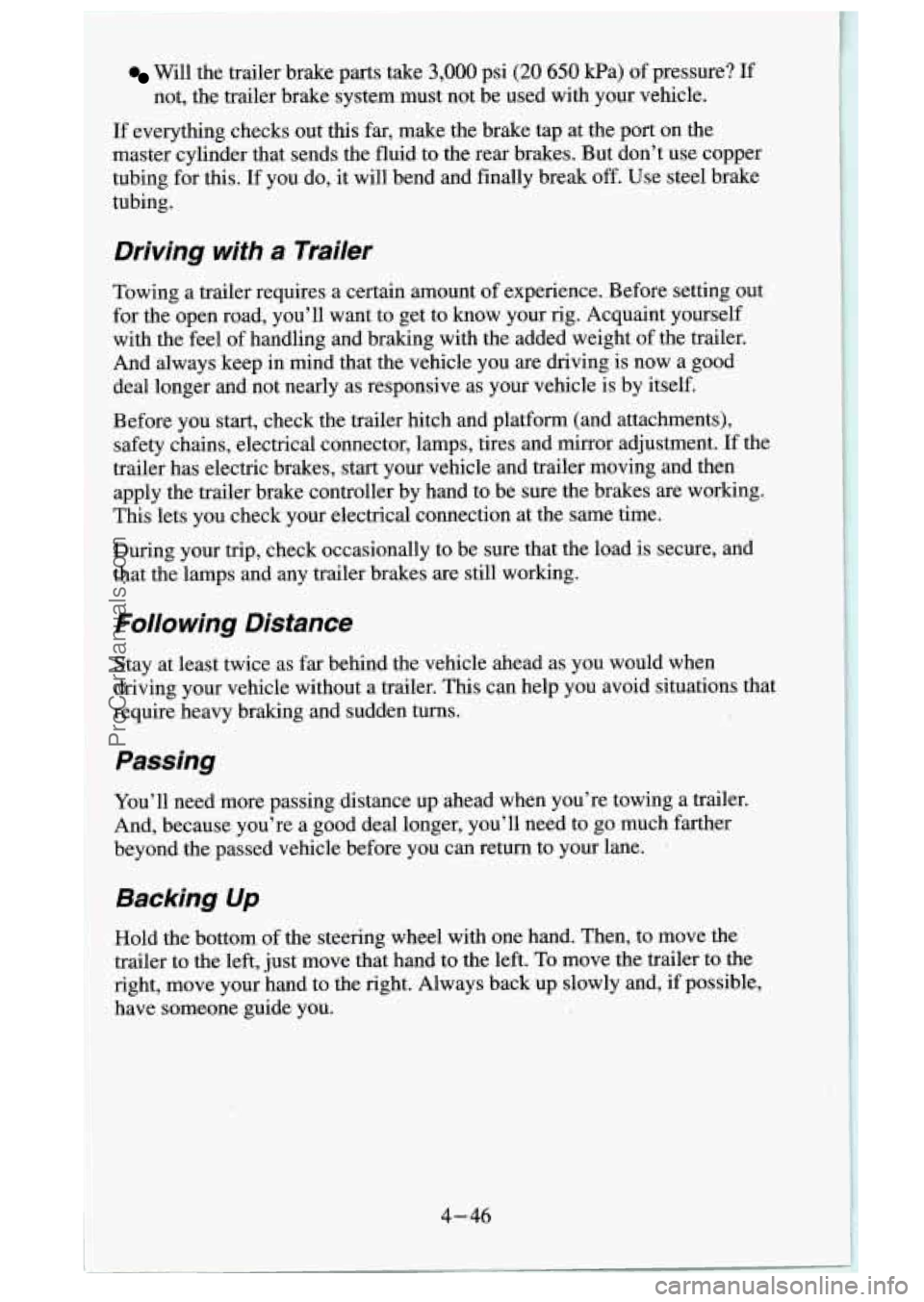
Will the trailer brake parts take 3,000 psi (20 650 Wa) of Ijressure? If
not, the trailer brake system must not be used with your vehicle.
Driving with a Trailer
Towing a trailer requires a certain amount of experience. Before setting out
for the open road, you’ll want to get to know your rig. Acquaint yourself
with the feel of handling and braking with the added weight of the trailer.
And always keep in mind that the vehicle you
are driving is now a good
deal longer and not nearly as responsive as your vehicle is by itself.
Before you start, check the trailer hitch and platform (and attachments),
safety chains, electrical connector, lamps, tires and mirror adjustment. If the
trailer has electric brakes, start your vehicle and trailer moving and then
apply the trailer brake controller by hand to be sure the brakes
are working.
‘This lets you check your electrical connection at the same \
time.
During your trip, check occasionally to be sure that the load is secure, and
that the lamps and any trailer brakes
are still working.
Following Distance
Stay at least twice as far behind the vehicle ahead as you would when
driving your vehicle without a trailer.
This can help you avoid situations that
require heavy braking and sudden turns.
Passing
You’ll need more passing distance up ahead when you’re towing a trailer.
And, because you’re a good deal longer, you’ll need to go much farther
beyond the passed vehicle before you can return to your lane.
.
Backing Up
Hold the bottom of the steering wheel with one hand. Then, to move the
trailer to the left, just move that hand to the left.
To move the trailer to the
right, move your hand to the right. Always back
up slowly and, if possible,
have someone guide you.
4-46
ProCarManuals.com
Page 271 of 488
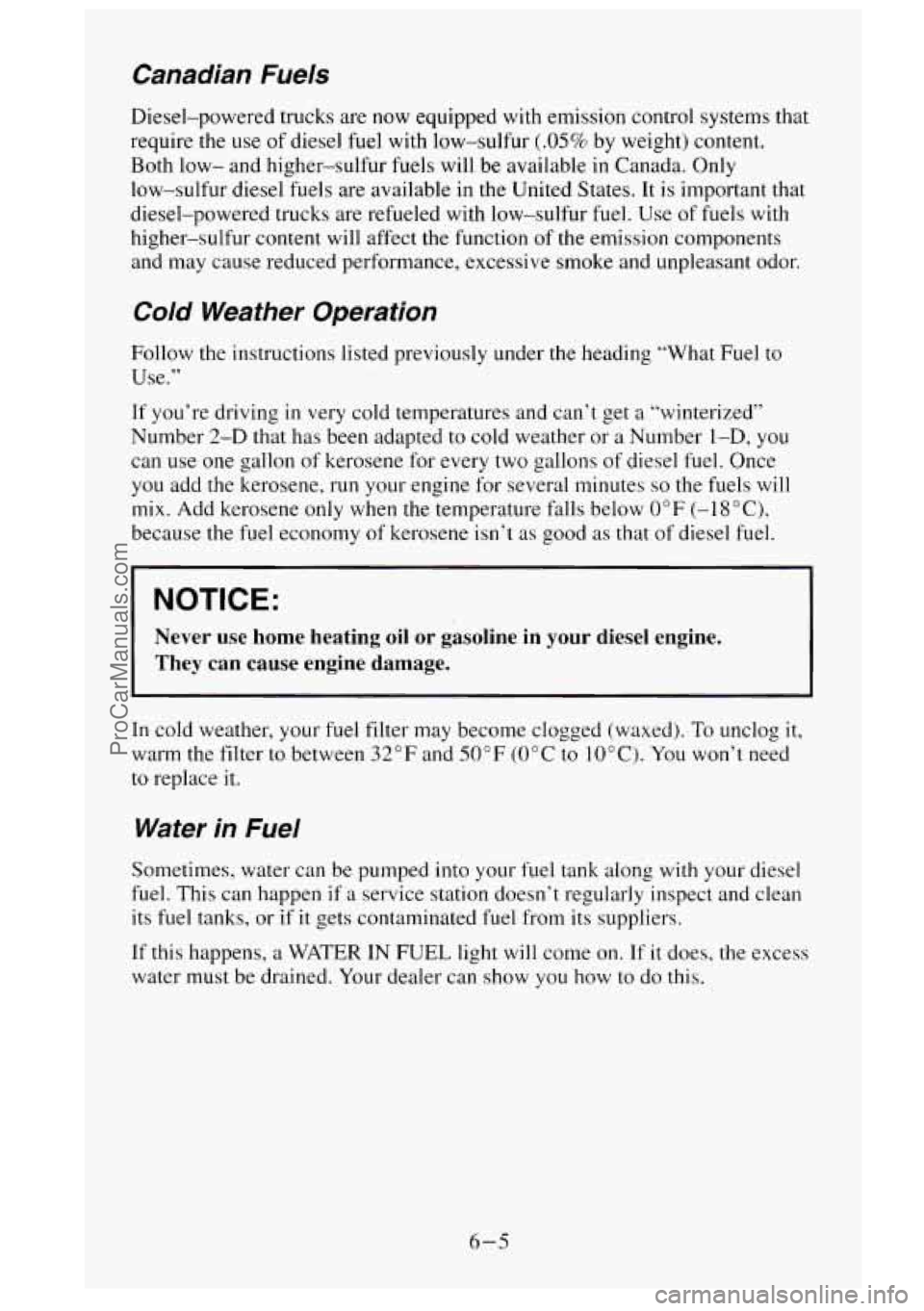
Canadian Fuels
Diesel-powered trucks are now equipped with emission control systems that
require the use of diesel fuel with low-sulfur
(.05% by weight) content.
Both low- and higher-sulfur fuels will be available
in Canada. Only
low-sulfur diesel fuels are available
in the United States. It is important that
diesel-powered trucks are refueled with low-sulfur fuel. Use of fuels with
higher-sulfur content will affect
the function of the emission components
and may cause reduced performance, excessive smoke and unpleasant odor.
Cold Weather Operation
Follow the instructions listed previously under the heading “What Fuel to
Use.”
If you’re driving
in very toold temperatures and can’t get a “winterized”
Number
2-D that has been adapted to cold weather or a Number 1-D, you
can
use one gallon of kerosene for every two gallons of diesel fuel. Once
you add the kerosene, run your engine for several minutes
so the fuels will
mix. Add kerosene only when the temperature falls below 0°F (-1 S”C),
because the fuel economy of kerosene isn’t as good as that of diesel fuel.
NOTICE:
Never use home heating oil or gasoline in your diesel engine. \
They can cause engine damage.
In cold weather, your fuel filter may become clogged (waxed). To unclog it,
warm the filter to between
32°F and 50°F (OOC to 10°C). You won’t need
to replace
it.
Water in Fuel
Sometimes, water can be pumped into your fuel tank along with your diesel
fuel. This can happen
if a service station doesn’t regularly inspect and clean
its fuel tanks, or
if it gets contaminated fuel from its suppliers.
If this happens, a WATER
IN FUEL light will come on. If it does, the excess
water must be drained. Your dealer can show
you how to do this.
6-5
ProCarManuals.com
Page 280 of 488
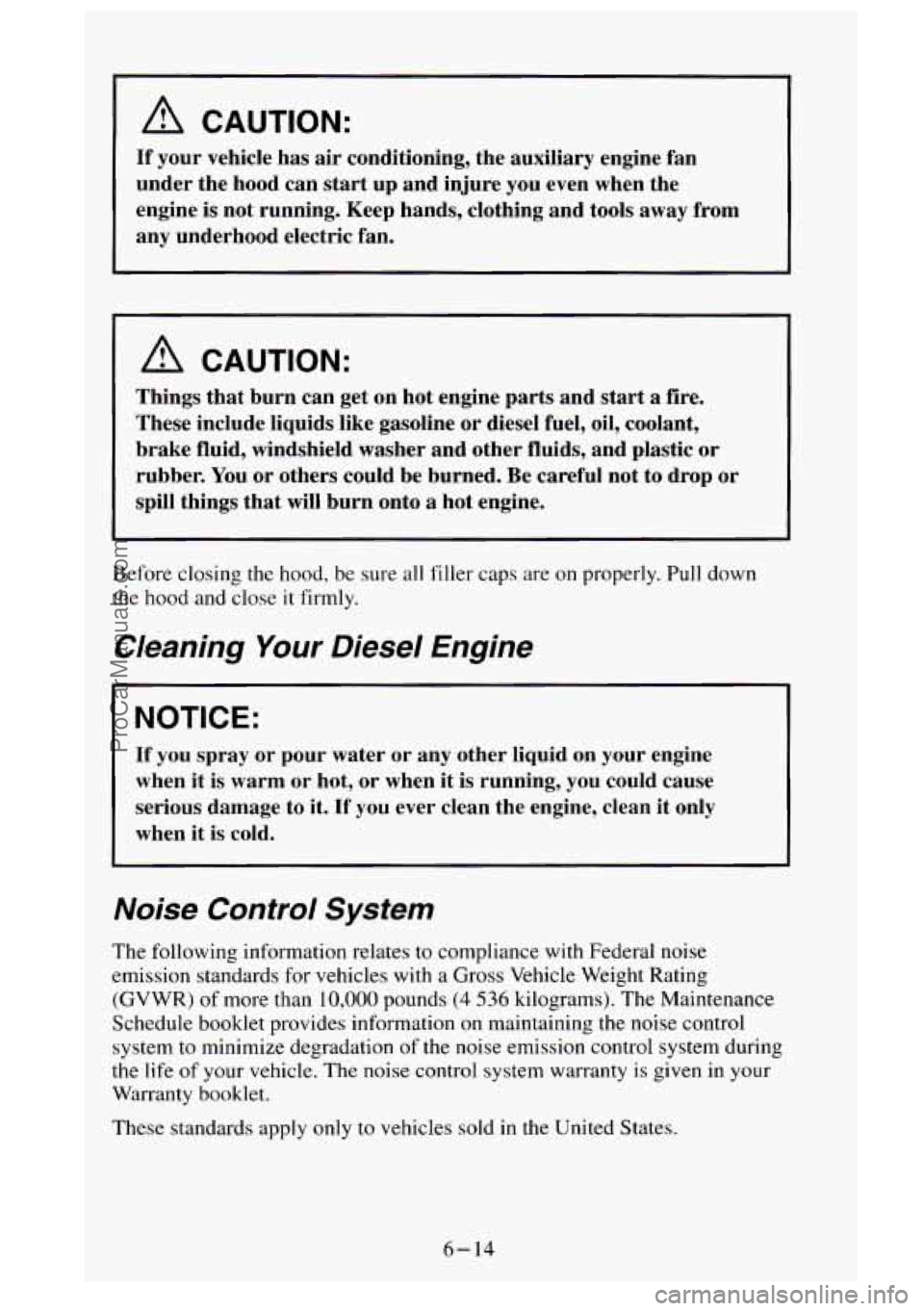
A CAUTION:
If your vehicle has air conditioning, the auxiliary engine fan
under the hood can start up and injure you even when the
engine is not running. Keep hands, clothing and tools
away from
any underhood electric fan.
A CAUTION:
Things that burn can get on hot engine parts and start a fire.
These include liquids like gasoline or diesel fuel, oil, coolant,
brake fluid, windshield washer and other fluids, and plastic
or
rubber. You or others could be burned. Be careful not to drop or
spill things that
will burn onto a hot engine.
Before closing the hood, be sure
all filler caps are on properly. Pull down
the
hood and close it firmly.
Cleaning Your Diesel Engine
I NOTICE:
If you spray or pour water or any other liquid on your engine
when it is warm or hot, or when it
is running, you could cause
serious damage to it.
If you ever clean the engine, clean it only
when it is cold.
Noise Control System
The following information relates to compliance with Federal noise
emission standards for vehicles with a Gross Vehicle Weight Rating
(GVWR)
of more than 10,000 pounds (4 536 kilograms). The Maintenance
Schedule booklet provides information on maintaining
the noise control
system to minimize degradation of the noise emission control system during
the life of your vehicle. The noise control system warranty is given in your
Warranty booklet.
These standards apply only
to vehicles sold in the United States.
6-14
ProCarManuals.com